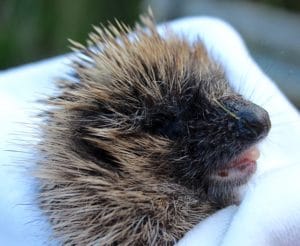Sanctuary Life
Injured baby hedgehog hanging on
The injured baby hedgehog is still with us. She’s a fighter and in spite of her wounds she is eating and trying to stand up. She’s breathing better and has her colour back. Her mouth was very pale yesterday. Her injuries are old ones and full of maggots, we flushed most of them out with salt water but have had to pick the rest out with tweezers. You might think that when maggots are eating away at an animal it would be all over but we’ve known them recover even with such a bad infestation.
Where have the maggots come from? It’s when flies lay their eggs in open flesh, then they hatch out. Another half hour though and it would have been all over for her. We’ve called her Kizzy, she’s a feisty little girl with a will to live. She knows we’re helping her and wants us to go on. When we had a pause in the maggot removal she began wriggling as if to stay ‘don’t stop’.
It’s still touch and go but she is drinking, from the syringe and licking up some solid food. If we keep her going till her injuries start healing we think she will survive. Kizzy is only a baby still and her spines are not so sharp as those of adults, this made it easier for a predator to attack her. Not many will attack an adult hedgehog who has sharp hard spines.
About 20per cent of young hedgehogs don’t survive more than four weeks once they have left the nest. First they have to get food and this depends largely on the weather. If it’s too dry or cold then their won’t be so many beetles, caterpillars, worms, eggs, dead birds and anything they can scavenge. This is all natural food for hedgehogs and the reason they like gardens so much is that their instincts tell them they’ll find food there. In a nice, not too neat garden, there’ll be plenty of shelter and places to call home – under sheds, in piles of logs, heaps of dead leaves. Please remember the hedgehogs, leave gaps in the hedges (so they can go walkabout) and don’t tidy up too much.


